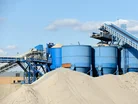Cement Industry key Target of $20bn US Decarbonisation Plan

The US Department of Energy (DOE) is to invest more than $20bn in decarbonising US industry, with construction a key part of this.
The investment is part of President Biden’s Investing in America Agenda, a comprehensive set of policy proposals designed to address important challenges facing the US, while promoting economic growth and resilience.
The decarbonisation drive will focus on the highest emitting industries, with cement and concrete, chemicals and refining and iron and steel among these.
Taken together the Biden-Harris administration is seeking to cut carbon emissions by more than 14 million metric tons each year – equivalent to the annual emissions of 3 million petrol-powered cars.
Under the plan, six cement and concrete projects have been earmarked for inclusion. These, say the DOE will deploy “a comprehensive set of technologies capable of eliminating all CO2 emissions from today’s plants”.
Together, the projects will develop new pathways for making traditional Portland cement with lower or zero emissions and to pioneer new materials and new mixtures that can drive the sector to zero emissions.
Zero emissions Portland cement is US goal
Portland cement is the most common type of cement used in construction worldwide. It's a fine powder made from a mixture of limestone, clay, iron ore and other ingredients, which are heated in a kiln at extremely high temperatures, and then ground into a fine powder that becomes Portland cement.
First produced in the early 19th century in England it is used for everything, including building roads, buildings, bridges and dams.
The DOE said: “This will help set the stage for a future where cement – one of the single largest sources of CO2 emissions globally – can be net-negative.
“These game-changing projects will revolutionise a sector that has relied on emissions-intensive processes for millennia.”
It said that carbon-cutting initiatives will “capture and sequester” emissions from one of the largest cement plants in the US, and will also include “pioneering chemistry changes to mitigate emissions at their source”.
“Our investments can fundamentally transform cement,” says the DOE. “Cement is the world’s most abundant man-made material and a building block of our world’s infrastructure.”
- Generation: How Green Trends are Impacting ConstructionSustainability & Green Building
- Hyundai Opens New Hub For Advanced Manufacturing EV TrainingTechnology & AI
- Microsoft’s AI Megasite: Redefining Data CentresTechnology & AI
- Explainer: Formwork - Shaping the Future of ConstructionBuilt Environment



